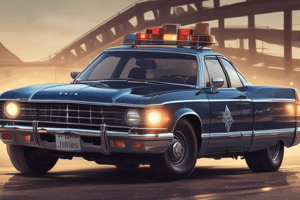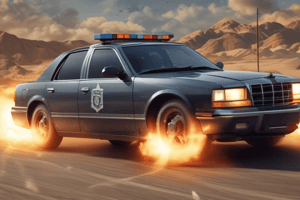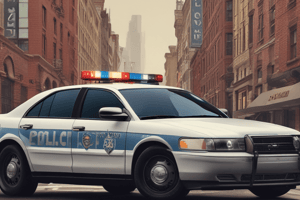Podcast
Questions and Answers
What must a police vehicle provide when initiating a pursuit?
What must a police vehicle provide when initiating a pursuit?
- The last known address of the suspect
- The name of the suspect
- Weather conditions in the area
- Location and direction of travel (correct)
Under what condition can police vehicles pursue a suspect through residential properties?
Under what condition can police vehicles pursue a suspect through residential properties?
- When the suspect is known to have a driver’s license
- When the pursuit is not monitored by a supervisor
- When the pursued suspect is dangerous and violent (correct)
- When the vehicle is stolen
How many police vehicles can be in actual pursuit at one time without a supervisor's order?
How many police vehicles can be in actual pursuit at one time without a supervisor's order?
- Four
- Three
- One
- Two (correct)
What is the primary responsibility of the second police vehicle in a pursuit?
What is the primary responsibility of the second police vehicle in a pursuit?
What should a supervisor of higher rank do if no supervisor has identified themselves during a pursuit?
What should a supervisor of higher rank do if no supervisor has identified themselves during a pursuit?
What criteria should a supervisor consider when deciding to increase the number of pursuing vehicles?
What criteria should a supervisor consider when deciding to increase the number of pursuing vehicles?
Which of the following factors is NOT considered by the field supervisor when evaluating a pursuit?
Which of the following factors is NOT considered by the field supervisor when evaluating a pursuit?
What is required of police vehicles engaged in a pursuit regarding emergency signals?
What is required of police vehicles engaged in a pursuit regarding emergency signals?
What should a field supervisor do if no sergeant is available for a pursuit?
What should a field supervisor do if no sergeant is available for a pursuit?
Under what conditions can a police pursuit be terminated without apprehension?
Under what conditions can a police pursuit be terminated without apprehension?
What must officers do immediately upon termination of a pursuit?
What must officers do immediately upon termination of a pursuit?
What should assisting police units do in relation to the pursued vehicle?
What should assisting police units do in relation to the pursued vehicle?
When is it appropriate to utilize 'felony stop' techniques?
When is it appropriate to utilize 'felony stop' techniques?
What should the primary and secondary pursuing officers do once adequate personnel arrive at the scene?
What should the primary and secondary pursuing officers do once adequate personnel arrive at the scene?
What is required if primary and secondary pursuing officers make an exception to transport a prisoner?
What is required if primary and secondary pursuing officers make an exception to transport a prisoner?
Who assumes responsibility for police actions relating to a pursuit at the termination point?
Who assumes responsibility for police actions relating to a pursuit at the termination point?
What is the primary purpose of the vehicle pursuit policy?
What is the primary purpose of the vehicle pursuit policy?
Under what conditions is pursuit driving permitted according to the policy?
Under what conditions is pursuit driving permitted according to the policy?
How is a 'pursuit' defined in this policy?
How is a 'pursuit' defined in this policy?
What must officers do when engaged in a pursuit with vehicles equipped with video cameras?
What must officers do when engaged in a pursuit with vehicles equipped with video cameras?
Why should police pursuits be approached with caution according to the policy?
Why should police pursuits be approached with caution according to the policy?
What type of violator pursuits are allowed according to the policy?
What type of violator pursuits are allowed according to the policy?
What is a significant concern regarding known or suspected violators fleeing from police?
What is a significant concern regarding known or suspected violators fleeing from police?
Who must give the order for a police pursuit to be initiated according to the policy?
Who must give the order for a police pursuit to be initiated according to the policy?
Who is responsible for determining the membership and frequency of meetings for the Pursuit Review Panel?
Who is responsible for determining the membership and frequency of meetings for the Pursuit Review Panel?
What will the Pursuit Review Panel analyze during their review process?
What will the Pursuit Review Panel analyze during their review process?
What is the role of the Deputy Chiefs of the Uniform Division concerning pursuit review reports?
What is the role of the Deputy Chiefs of the Uniform Division concerning pursuit review reports?
Which specific technique is forbidden under the Indiana Law Enforcement Training Board's policy on vehicle pursuits?
Which specific technique is forbidden under the Indiana Law Enforcement Training Board's policy on vehicle pursuits?
What is the primary purpose of the Pursuit Review Panel?
What is the primary purpose of the Pursuit Review Panel?
What must a field supervisor do after an interjurisdictional pursuit concludes?
What must a field supervisor do after an interjurisdictional pursuit concludes?
Under what conditions may roadblocks be established during a vehicle pursuit?
Under what conditions may roadblocks be established during a vehicle pursuit?
What is the minimum staffing requirement for an ideal fixed roadblock?
What is the minimum staffing requirement for an ideal fixed roadblock?
Which of the following actions is prohibited regarding vehicle pursuits?
Which of the following actions is prohibited regarding vehicle pursuits?
How should a shift commander handle a roadblock
How should a shift commander handle a roadblock
What type of vehicles may tire deflation devices (TDDs) be used against?
What type of vehicles may tire deflation devices (TDDs) be used against?
Which scenario is not acceptable during a vehicle pursuit?
Which scenario is not acceptable during a vehicle pursuit?
What is the primary goal of implementing safety measures during vehicle pursuits?
What is the primary goal of implementing safety measures during vehicle pursuits?
What is required for the deployment of Tire Deflation Devices (TDDs)?
What is required for the deployment of Tire Deflation Devices (TDDs)?
In which situation can TDDs be deployed without prior supervisor approval?
In which situation can TDDs be deployed without prior supervisor approval?
Which vehicles should TDDs not be used against?
Which vehicles should TDDs not be used against?
What must officers communicate when deploying TDDs?
What must officers communicate when deploying TDDs?
What is the procedure after TDDs are deployed and run over by a vehicle?
What is the procedure after TDDs are deployed and run over by a vehicle?
Who is responsible for submitting a detailed report after TDD deployment?
Who is responsible for submitting a detailed report after TDD deployment?
What should a supervisor consider before authorizing TDD deployment?
What should a supervisor consider before authorizing TDD deployment?
In which of the following areas are TDDs prohibited from being deployed?
In which of the following areas are TDDs prohibited from being deployed?
Flashcards
Vehicle Pursuit
Vehicle Pursuit
The practice where law enforcement officers in vehicles pursue a suspect in another vehicle to apprehend them.
Pursuit Driving
Pursuit Driving
The act of driving in a sustained manner, with the intention of catching a suspect in a vehicle, while the suspect is also in a vehicle.
Felon
Felon
A known or suspected criminal who has committed a serious crime.
Traffic or Miscellaneous Violators
Traffic or Miscellaneous Violators
Signup and view all the flashcards
Communications Department Personnel
Communications Department Personnel
Signup and view all the flashcards
Mobile Video Cameras
Mobile Video Cameras
Signup and view all the flashcards
Escape Apprehension
Escape Apprehension
Signup and view all the flashcards
Jeopardy to Citizenry
Jeopardy to Citizenry
Signup and view all the flashcards
What must officers do when engaging in a vehicle pursuit?
What must officers do when engaging in a vehicle pursuit?
Signup and view all the flashcards
What are the requirements for emergency equipment during a pursuit?
What are the requirements for emergency equipment during a pursuit?
Signup and view all the flashcards
What are the limitations for pursuing vehicles into residential areas?
What are the limitations for pursuing vehicles into residential areas?
Signup and view all the flashcards
How many police vehicles should participate in an active pursuit by default?
How many police vehicles should participate in an active pursuit by default?
Signup and view all the flashcards
When would you increase the number of police vehicles in a pursuit?
When would you increase the number of police vehicles in a pursuit?
Signup and view all the flashcards
What role does the second vehicle play in a pursuit?
What role does the second vehicle play in a pursuit?
Signup and view all the flashcards
What are the limitations for additional assisting police units during a pursuit?
What are the limitations for additional assisting police units during a pursuit?
Signup and view all the flashcards
What is the supervisor's responsibility during a pursuit?
What is the supervisor's responsibility during a pursuit?
Signup and view all the flashcards
Pursuit Review Panel
Pursuit Review Panel
Signup and view all the flashcards
Indiana Law Enforcement Training Board Policy
Indiana Law Enforcement Training Board Policy
Signup and view all the flashcards
Precision Immobilization Technique (PIT)
Precision Immobilization Technique (PIT)
Signup and view all the flashcards
Annual Pursuit Analysis
Annual Pursuit Analysis
Signup and view all the flashcards
Forcible Stopping of Suspect Vehicle
Forcible Stopping of Suspect Vehicle
Signup and view all the flashcards
Roadblock
Roadblock
Signup and view all the flashcards
Tire Deflation Device (TDD)
Tire Deflation Device (TDD)
Signup and view all the flashcards
Ramming
Ramming
Signup and view all the flashcards
Moving Roadblock
Moving Roadblock
Signup and view all the flashcards
Supervisor Responsibility after Pursuit
Supervisor Responsibility after Pursuit
Signup and view all the flashcards
Exhausting All Other Efforts Before Roadblock
Exhausting All Other Efforts Before Roadblock
Signup and view all the flashcards
What is a vehicle pursuit?
What is a vehicle pursuit?
Signup and view all the flashcards
Who monitors vehicle pursuits?
Who monitors vehicle pursuits?
Signup and view all the flashcards
What factors does a supervisor consider during a pursuit?
What factors does a supervisor consider during a pursuit?
Signup and view all the flashcards
When can a pursuit be stopped?
When can a pursuit be stopped?
Signup and view all the flashcards
What happens to officers after a pursuit ends?
What happens to officers after a pursuit ends?
Signup and view all the flashcards
Who takes charge after a pursuit ends?
Who takes charge after a pursuit ends?
Signup and view all the flashcards
What happens when a suspect is caught during a pursuit?
What happens when a suspect is caught during a pursuit?
Signup and view all the flashcards
Who transports a suspect after a pursuit?
Who transports a suspect after a pursuit?
Signup and view all the flashcards
Who Authorizes TDD Deployment?
Who Authorizes TDD Deployment?
Signup and view all the flashcards
When are TDDs Not Allowed?
When are TDDs Not Allowed?
Signup and view all the flashcards
What Happens Before TDD Deployment?
What Happens Before TDD Deployment?
Signup and view all the flashcards
What Happens After TDD Deployment?
What Happens After TDD Deployment?
Signup and view all the flashcards
What Reports Must be Filed After TDD Deployment?
What Reports Must be Filed After TDD Deployment?
Signup and view all the flashcards
Who Compiles and Submits Pursuit Reports?
Who Compiles and Submits Pursuit Reports?
Signup and view all the flashcards
What is Required for TDD Deployment?
What is Required for TDD Deployment?
Signup and view all the flashcards
When is TDD Use Justified?
When is TDD Use Justified?
Signup and view all the flashcards
Study Notes
Vehicle Pursuit Policy (PD97-0113)
- Purpose: To provide guidelines for officers engaging in motor vehicle pursuits of law violators.
- Policy: Law enforcement acknowledges that known or suspected violators will attempt to evade arrest. Pursuing officers must balance the need to apprehend the violators against the risk to public safety.
- Definition: A "pursuit" is a sustained chase of a suspected law violator in motorized vehicles, not necessarily at high speeds.
- Procedures:
- Pursuit driving permitted: For felons, traffic violators, or when ordered by supervisors to assist other pursuing vehicles.
- Notification: Any pursuing vehicle must immediately notify communications of: vehicle identification, location and travel direction, the reason for the pursuit, description of the pursued vehicle (if possible), and all relevant info.
- Conditions: Emergency lights and sirens must be active. Precautionary measures need to be taken by the pursuing vehicle(s) to maximize public and officer safety. Pursuits should avoid residential areas.
- Assisting units: No more than 2 vehicles should pursue unless directed by a supervisor, and additional considerations must be made to include specialized units for risk assessments.
- Supervisor's responsibility: Supervisors are responsible for monitoring pursuit progress and safety. They are responsible for ensuring that units involved in the pursuit maintain proper safety measures for the safety of the public and the officers.
- Termination of pursuit: Pursuit can be terminated when directed by a Supervisor; or in situations such as pursuit progressing in a way that increases risk; pursuit can also be terminated when apprehensions are made.
- Unmarked vehicles: Unmarked vehicles are permitted to initiate a pursuit provided they have flashing red/blue lights and sirens.
- Interjurisdictional pursuits: Pursuing personnel must convey the facts of the pursuit to communications and relevant agencies. The supervisor will indicate how many units should initiate pursuit.
- Forcible Stopping: Officers are not allowed to intentionally ram or contact the person being pursued.
- Roadblocks: May be legally used in some circumstances, but there must be a clear and present danger to other citizens due to the actions of the pursued vehicle. Roadblocks are to be implemented under direction from a shift commander.
- Tire Deflation Devices (TDDs): May be employed, but only with approval from a supervisor, and only in certain situations.
- Reporting requirements: Detailed reports are required for all pursued incidents, and the supervisors and officers must submit these reports as part of the proper documentation procedure.
- Pursuit Review Panel: A panel is convened to investigate pursuits and review policies. This panel reports findings to the Chief of Police.
Studying That Suits You
Use AI to generate personalized quizzes and flashcards to suit your learning preferences.
Related Documents
Description
This quiz covers the key elements of the Vehicle Pursuit Policy PD97-0113, which provides guidelines for law enforcement officers during motor vehicle pursuits. It discusses the balance between apprehending violators and ensuring public safety, along with procedural requirements for pursuits. Engage in this quiz to test your understanding of pursuit driving and its regulations.




